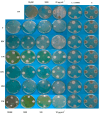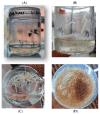Antifungal Activity of Ethanolic Extracts from Aeroponically Grown Cape Gooseberry (Physalis peruviana L.) with LED Lights and In Vitro Habituated Roots
- PMID: 39771284
- PMCID: PMC11678921
- DOI: 10.3390/plants13243586
Antifungal Activity of Ethanolic Extracts from Aeroponically Grown Cape Gooseberry (Physalis peruviana L.) with LED Lights and In Vitro Habituated Roots
Abstract
Green mold caused by Penicillium digitatum is a major post-harvest disease in citrus fruits. Therefore, the search for sustainable and low-environmental-impact alternatives for the management of these fungi is of utmost importance. Physalis peruviana L. is a native fruit of the Peruvian Andes with rich bioactive components present throughout the plant. Its antifungal activity stands out, attributed to its high content of phenols, coupled with its antioxidant capacity and antimicrobial activity. Plants were cultivated aeroponically under a combination of red, mixed (50% red, 50% blue), and green LED lights. Additionally, in vitro-habituated roots free of plant growth regulators were also cultivated. An ethanol extraction assisted by ultrasound for 30 min followed by maceration for 72 h was performed, and the extract was filtrated and evaporated in an extraction hood. Antioxidant activity was assessed using the DPPH method, total polyphenols were measured using the Folin-Ciocâlteu method, and an antifungal test in vitro by the poisoned food method was conducted against P. digitatum. In vitro assays revealed that extracts from leaves, roots, and fruits exerted a significant inhibitory effect on the growth of P. digitatum, as evidenced by a reduction in colony radius when cultured employing the poisoned food method, with IC50 values of 62.17, 53.15, and 286.34 µg·mL-1, respectively, compared to 2297 µg·mL-1 for the commercial fungicide Captan 50WP. Although leaves had higher total polyphenol content, no direct correlation with antifungal activity was found. Colored LEDs enhanced phenol accumulation, antioxidant capacity, and antifungal properties in plant parts compared to white LEDs and in vitro roots. These findings suggest P. peruviana as a new alternative biological production system to provide natural compounds for post-harvest disease management.
Keywords: Cape gooseberry; antifungal activity; indoor farming.
Conflict of interest statement
The authors declare no conflicts of interest.
Figures







Similar articles
-
Influence of cultivar and ripening time on bioactive compounds and antioxidant properties in Cape gooseberry (Physalis peruviana L.).J Sci Food Agric. 2015 May;95(7):1562-9. doi: 10.1002/jsfa.6866. Epub 2014 Sep 1. J Sci Food Agric. 2015. PMID: 25131258
-
QTOF-ESI MS Characterization and Antioxidant Activity of Physalis peruviana L. (Cape Gooseberry) Husks and Fruits from Costa Rica.Molecules. 2022 Jun 30;27(13):4238. doi: 10.3390/molecules27134238. Molecules. 2022. PMID: 35807484 Free PMC article.
-
Chemical Characterization, Nutritional and Bioactive Properties of Physalis peruviana Fruit from High Areas of the Atacama Desert.Foods. 2021 Nov 4;10(11):2699. doi: 10.3390/foods10112699. Foods. 2021. PMID: 34828980 Free PMC article.
-
Antibacterial, antifungal and antioxidant activity of total polyphenols of Withania frutescens.L.Bioorg Chem. 2019 Dec;93:103337. doi: 10.1016/j.bioorg.2019.103337. Epub 2019 Oct 8. Bioorg Chem. 2019. PMID: 31627061 Review.
-
Alternative Management Approaches of Citrus Diseases Caused by Penicillium digitatum (Green Mold) and Penicillium italicum (Blue Mold).Front Plant Sci. 2022 Feb 22;12:833328. doi: 10.3389/fpls.2021.833328. eCollection 2021. Front Plant Sci. 2022. PMID: 35273621 Free PMC article. Review.
References
-
- Ismail M., Zhang J.Z. Post-harvest citrus diseases and their control. Outlooks Pest Manag. 2004;15:29–35. doi: 10.1564/15feb12. - DOI
-
- Amiri A., Bompeix G. Diversity and population dynamics of Penicillium spp. on apples in pre- and postharvest environments: Consequences for decay development. Plant Pathol. 2005;54:74–81. doi: 10.1111/j.1365-3059.2005.01112.x. - DOI
-
- Dennis C. Postharvest Pathology of Fruits and Vegetables. Academic Press; London, UK: 1983. 264p
-
- Sanderson P.G., Spotts R.A. Postharvest decay of winter pear and apple fruit caused by species of Penicillium. Phytopathology. 1995;85:103–110. doi: 10.1094/Phyto-85-103. - DOI
LinkOut - more resources
Full Text Sources

